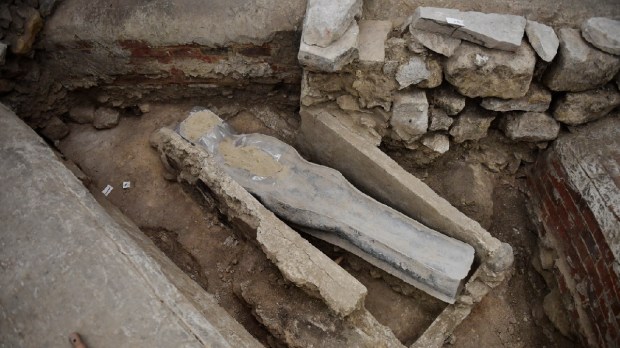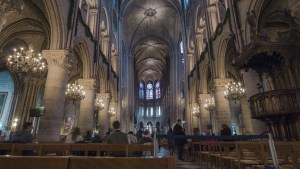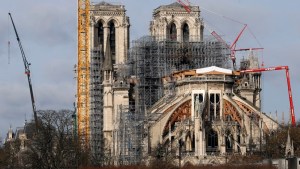A team of French experts has identified the remains within one of the two sarcophagi discovered underneath Notre Dame de Paris after the April 2019 fire. While the name of the deceased within the second sarcophagus still eludes them, the team has narrowed down the man’s station and believe his interment in the cathedral occurred around the 15th century.
Aleteia previously reported that the two sarcophagi were discovered while construction teams were examining the floor after the fire. The floor needed to be deemed sturdy enough to support the rafters required of the reconstruction effort. After their discovery, work was halted for a time as a team of archaeologists excavated the tombs.
Antione de la Porte
The Guardian reports that the first sarcophagus, found just eight inches below the floor, belonged to Antoine de la Porte. Porte was the canon of Notre Dame Cathedral, and died on Christmas Eve 1710, aged 83. While the lead sarcophagus was pliable enough to be punctured, causing oxygen to degrade the organic material within, the team was able to examine the cleric’s bones, hair, and beard, which remained intact.
Antoine de la Porte was easily identified, thanks to a brass plaque on the sarcophagus that bore his name. Experts said that his remains suggest that he led a somewhat sedentary lifestyle and he took particularly good care of his teeth. Historically, de la Porte was known as a rich and influential figure, who was a great patron of the arts. Some of the artworks he commissioned are still on display today in the Louvre.
De la Porte was also known for renovating the Notre Dame Cathedral’s choir, which cost an astounding 10,000 livres (over $2.6 million today). This also explains why his remains were found beside pieces of the original rood screen of the cathedral choir, which were used to construct his tomb.
“The cavalier”
The second sarcophagus is giving the team a little more trouble in its identification, not just because there was no plaque with a name, but also because it is older than the first. Found several feet below Antoine de la Porte, this sarcophagus was also made of lead and was also penetrated while underground. The oxygen that leaked in over the centuries has decayed much of the remains.
Still, the team was able to identify that “the cavalier,” as they call him, was a young man of the aristocratic class just from the fact that he was interred within the cathedral. Science Alert notes his remains showed that his teeth were in particularly bad condition, in contrast to de la Porte’s teeth, and they suspect he suffered from a chronic condition that accelerated their decay. Furthermore, his skull showed signs that his head had been bound in order to deform and elongate the skull, which was a practice of some medieval aristocratic families.
The Guardian has comments from Christophe Besnier, head of the dig team from France’s national archaeological institute, Inrap:
“If the date of his death was around the second half of the 16th century or early 17th century, we may be able to identify him in the death register that we have. If it’s earlier than that, we probably won’t ever know who he was.”
Read more about the fascinating results of Inrap’s examinations at The Guardian.



